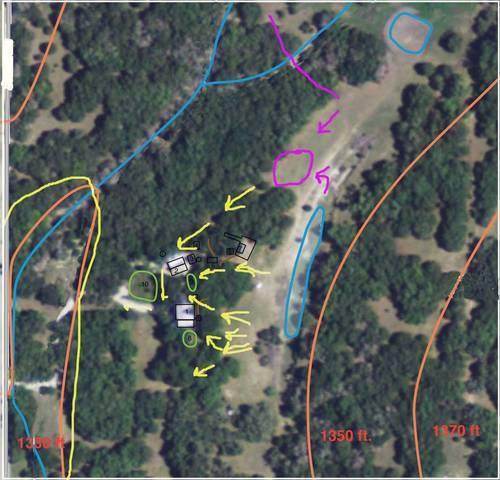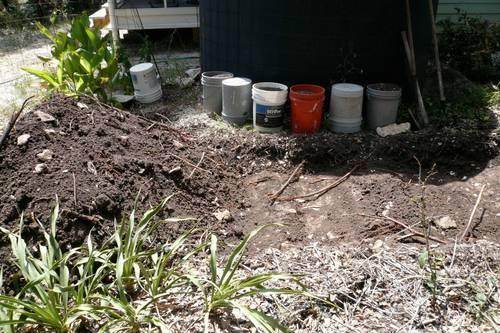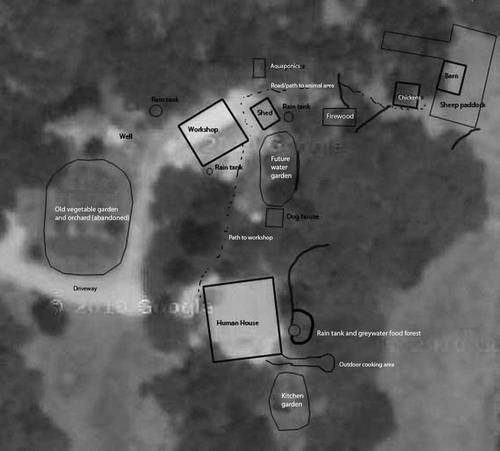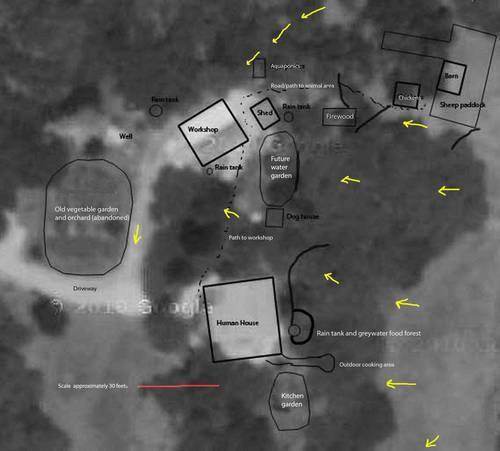


10 Podcast Review of the book Just Enough by Azby Brown
will be released to subscribers in:
soon!







Idle dreamer




 . That pic someone posted of the house with the tree that fell over taking the whole yard with it looked like maybe 12" at best.
. That pic someone posted of the house with the tree that fell over taking the whole yard with it looked like maybe 12" at best.




M Troyka wrote: I'm curious as to why you've arranged your gardens in blobs, though. They don't seem to work with the water flow much, although I could be mistaken.
Idle dreamer






Idle dreamer




Tyler Ludens wrote:[Not sure what you mean by "blobs" nor how they should work better with the water flow. Water flows off the back field into the kitchen garden and future water garden, and water flows from the shop area and driveway into the large garden below the house area. With a couple more earthworks and a little more work on the driveway, more water should be directed into the gardens.




M Troyka wrote:
Your gardens are planted in french style "beds".
M Troyka wrote:I'll post a pic in a bit showing more what I'm talking about.
Idle dreamer




Tyler Ludens wrote:
M Troyka wrote:
Your gardens are planted in french style "beds".
No, I don't think so. The garden shapes are dictated by the shape of the open ground and a shape which is easy to fence (a round shape).....
Tyler Ludens wrote:
M Troyka wrote:I'll post a pic in a bit showing more what I'm talking about.
Thank you.
![Filename: MTWaterPlan.jpg
Description: [Thumbnail for MTWaterPlan.jpg]](/t/11215/a/5091/MTWaterPlan.jpg)





Idle dreamer




Tyler Ludens wrote:That's extremely helpful, thank you!

 . I could use the practice.
. I could use the practice.




Idle dreamer
 1
1





Idle dreamer




 1
1




Idle dreamer




Tyler Ludens wrote:Buckets in the pile are where holes will be for the figs and elderberry:
My project thread
Agriculture collects solar energy two-dimensionally; but silviculture collects it three dimensionally.





Idle dreamer




Idle dreamer




Idle dreamer




Idle dreamer





Idle dreamer










Idle dreamer




My project thread
Agriculture collects solar energy two-dimensionally; but silviculture collects it three dimensionally.




Idle dreamer




My project thread
Agriculture collects solar energy two-dimensionally; but silviculture collects it three dimensionally.




My project thread
Agriculture collects solar energy two-dimensionally; but silviculture collects it three dimensionally.




My project thread
Agriculture collects solar energy two-dimensionally; but silviculture collects it three dimensionally.





Idle dreamer
 1
1




Tyler Ludens wrote:I'm interested in getting help in arranging the elements of my zones 1 and 2, such as the sheds, animal houses, firewood storage, paths, rain tanks, garden areas, etc in relation to each other so that the entire design works as a whole system. That's what I'm really hoping to get help with here at this point.
My project thread
Agriculture collects solar energy two-dimensionally; but silviculture collects it three dimensionally.




Can you explain why they aren't working as set up now?
Existing elements that provide water:
2 rain tanks
Grey water
Well
Non existing elements that might provide water:
Rain tanks off every building/shed
Swales
Hugelkultures
Pond
???
Idle dreamer




Tyler Ludens wrote:For instance, if swales are suggested where should they be placed in the system? One of the challenges of the site is all the existing native trees. Some of the oaks are dying which will allow more room for water harvesting structures maybe swales or hugelkultur and food forest.
My project thread
Agriculture collects solar energy two-dimensionally; but silviculture collects it three dimensionally.




Cj Verde wrote:
And the tricky part:
Each element that needs water should have 2 ways to get water:
So Sheep get water via:
1: (put existing way here)
2: (put backup plan here)
Chickens get water via:
1: (put existing way here)
2: (put backup plan here)
Each element that provides water should deliver to 2 elements:
Rain tank off house goes to:
1: food forest
2: kitchen garden
My project thread
Agriculture collects solar energy two-dimensionally; but silviculture collects it three dimensionally.




My project thread
Agriculture collects solar energy two-dimensionally; but silviculture collects it three dimensionally.




Cj Verde wrote:You sort of want the whole system looked at
Idle dreamer




Cj Verde wrote:
Can you work a swale into the HK you're building?
Idle dreamer











Idle dreamer






Idle dreamer
 1
1














